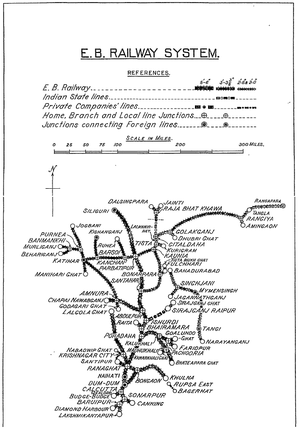East Bengal Railway Bridges: Difference between revisions
Paragraph added with 1937 Report info |
Internal links added |
||
| Line 1: | Line 1: | ||
''' | '''Eastern Bengal Railway - Lines owned and worked''' | ||
The '''[[ | <blockquote>- a sub-section of the '''[[Eastern Bengal Railway]]'''(EBR) page</blockquote> | ||
<blockquote>- see also separate page '''[[Eastern Bengal Railway - Lines owned and worked|East Bengal Railway Bridges - Lines owned and worked]]'''</blockquote> | |||
[[File:East Bengal Railway System 1937 Map.png|thumb| EBR Railway System 1937 Map]] | |||
The '''[[East Bengal Railway]] ''' (EBR) engaged [[Bradford Leslie]] as Resident Engineer from 1858 in-charge of construction of large bridges and viaducts.:- | |||
[[File: East Bengal Railway Bridges.png|thumb| East Bengal Railway Bridges ]] | [[File: East Bengal Railway Bridges.png|thumb| East Bengal Railway Bridges ]] | ||
Latest revision as of 10:20, 1 January 2021
Eastern Bengal Railway - Lines owned and worked
- a sub-section of the Eastern Bengal Railway(EBR) page
- see also separate page East Bengal Railway Bridges - Lines owned and worked

The East Bengal Railway (EBR) engaged Bradford Leslie as Resident Engineer from 1858 in-charge of construction of large bridges and viaducts.:-

Kumar River Railway Bridge
Marked A on map
Construction of the Kumar River bridge, which was carried on caissons founded by compressed air [1].
‘Kumar River Bridge’ ; north from Ranaghat Junction at Alamdanga crossing the river just south of the Sara Ghat Junction. On the ‘EBR Main Line - Eastern Division’ Ranagrat to Porada Junction Section opened 15 Nov 1862
Ichamati River Railway Bridge
Marked B on map
Construction of the Ichamati River bridge, which was carried on caissons founded by compressed air. [1].
‘Ichamati River Bridge’; at Bangaon crossing the river towards Jessore. Modern name Satvai Kalitala Bridge, on the ‘EBR Main Line - Central Division’ Bangoan to Khulna Section opened 16 Feb 1884
Gorai River Railway Bridge
Marked C on map
Construction commenced c.1865, near Kushtia , involved the bridging of the Gorai river on the ‘EBR Golundo Extension - Eastern Division ’ Porada Junction to Goalundo Section opened 1 Jan 1871
The Gorai Bidge marks the first of Bradford Leslie’s large bridge-building achievements in the Indian Empire. It consisted of seven 185-foot spans, supported on eight piers having two iron cylinders each; and was remarkable for the ingenious boring gear used to sink the cylinders to a depth of nearly 100 feet [1]. Two Papers delivered to the Institution of Civil Engineers clearly describe the complexity of this work [2] [3].
A Photographs Album in the British Library mainly records bridge-building activities c.1869-70, in particular the bridge over the Gorai River in Nadia district, West Bengal [4]. A letter by Bradford Leslie, the compiler of the album (or at the least the collector of some of the prints), indicates that Dr. J.A. Temple was employed as an engineer on the line. People named in these various photographs are Young, Haines, Pearce, Aylin, and Hayes. No initials given or job titles
The ‘Gorai Bridge’ was built with 7 spans of 180 foot (55 Mtr) girders. Since opening in 1871 the girders had become weak and distorted entailing severe restrictions to train services and also the use of modern locomotives and rolling stock, it was found necessary to consider their renewal. At first, with the prospect of the EBR ‘Goalundo Branch’ attaining the importance of a through route to Eastern Bengal in conjunction with the proposed ‘Dacca-Aricha Railway Project’ it was proposed to rebuild the ‘Gorai Bridge’ to modern standards at a cost of about Rs.70 lakhs. With the abandonment of the ’Dacca-Aricha Project’, the bridge ceased to be of major importance. A modified scheme was approved in Sept 1936 to renew only the girders and to strengthen the original piers, at a cost of Rs. 12.70 lakhs. Though urgent the work could not commence till November owing to an abnormal late rise in the river level. Three spans were renewed during the year, leaving four to be dealt with in 1937-38[5].
References
- ↑ 1.0 1.1 1.2 Grace’s Guide ‘Bradford Leslie’ ; Retrieved 28 Apr 2020
- ↑ ‘Paper delivered to Institution of Civil Engineers 13 Feb 1872 ‘Account of the Bridge over the Gorai River, on the Goalando Extension of the Eastern Bengal Railway’ by Bradford Leslie; Retrieved 28 Apr 2020
- ↑ ‘Discussion - Account of the Bridge over the Gorai River’ by Bradford Leslie; Retrieved 28 Apr 2020
- ↑ "India Office Records "Photographs Album for shelfmark Photos 230/(1) to 230(44) "Construction of the East Bengal Railway from Calcutta through Nadia and Faridpur districts, c.1869-70"; Retrieved 29 Apr 2020
- ↑ “Report by the Railway Board on Indian Railways for 1936-37. Vol. I; Railway Department, Government of India” Para 43 (i), page 42 pdf 57; Retrieved 20 Jul 2020